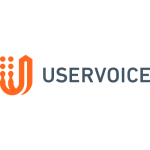About ChartMogul
ChartMogul can turn new and existing business intelligence data into valuable analytics that companies can use to improve their market performance. ChartMogul can take subscriber data - both created within ChartMogul and imported from other data sources - and generate visualized analytics for a variety of metrics that SaaS companies care about.
About UserVoice
UserVoice offers product developers a single interface that collects and analyzes customer feedback from a variety of sources. This gives product makers clear, actionable insights into how to improve their offerings. UserVoice eliminates the need to send out surveys, log emails, and search through message boards when trying to understand customer experiences. When a customer reports a complaint or submits an enhancement request through UserVoice, the customer stays in the loop with updates on how their submission is being considered and resolved. This boosts customer engagement and willingness to provide feedback and ideas for product improvement in the future.
Popular Use Cases
Bring all your ChartMogul data to Amazon Redshift
Load your ChartMogul data to Google BigQuery
ETL all your ChartMogul data to Snowflake
Move your ChartMogul data to MySQL
Bring all your UserVoice data to Amazon Redshift
Load your UserVoice data to Google BigQuery
ETL all your UserVoice data to Snowflake
Move your UserVoice data to MySQL
ChartMogul's End Points
ChartMogul Plans
Gather data about your subscription plans - like the subscription IDs, names, billing intervals, and the number of intervals that are charged at once - to evaluate the performance of each plan. This will help you better understand the effectiveness of your plans so that you can determine which ones are more or less successful as a whole.
ChartMogul Customers
Create, retrieve, or update data for new or imported customers in ChartMogul. This allows you to see important customer contact details, customer IDs, and valuable performance data including a customer’s MRR, ARR, and industry sector. You can then use that data to better segment your customers, which can provide more accurate and specific information about your business performance.
ChartMogul Invoices
Import invoice data for customers that you are tracking through ChartMogul, including customer IDs, dates of purchase, transactions, and any relevant line items. Then, use ChartMogul to create subscription data for those customers and use that data to track more specific revenue data, both in ChartMogul and in your other data sources.
ChartMogul Transactions
Track payments or refunds made on an invoice to see the transaction ID, type of transaction, transaction date, and whether or not the transaction was successful. This can help you get more accurate analytics from your invoice data. It can also indicate when there is an unusually high number of refunds, which could signal a problem worth addressing.
ChartMogul Subscriptions
Get a list of subscriptions that ChartMogul has automatically generated from invoice data. This endpoint returns several IDs - including subscription IDs, customer IDs, plan IDs, and data source IDs - that will help you to more easily track and integrate data between any of those parameters to create deeper, more accurate business analytics.
ChartMogul Tags
Use tags to track terms that are associated with a customer so that you can segment or monitor them more specifically. For example, you could tag a particular customer as “high priority,” “returning” or anything else that is relevant to your business, and then retrieve a list of customers who have been tagged with those attributes in order to analyze them as a segment.
ChartMogul Custom Attributes
Update customer data with ChartMogul custom attributes that are more specific to the needs of your company. This can include both tags as well as more complex custom attributes. Then, track those attributes in ChartMogul to get analytics that are focused on your particular business concerns.
UserVoice's End Points
UserVoice Turnkey Install-less Feedback
UserVoice includes a custom-brandable, stand-alone web portal, where your customers can go to provide direct feedback. Users can type in their feedback while receiving auto-suggestions to match their feedback with existing user suggestions. This reduces the chance of feedback duplication and facilitates the surfacing of top ideas. If an issue or enhancement suggestion doesn't exist, users can add a new one. Then, other customers can upvote the suggestion to help you understand the requests to address with the highest priority.
UserVoice In-App Feedback Channel Integration
UserVoice offers cut-and-paste Javascript code that you can insert into your applications and webpages. This embeds a 'Give Feedback' button so users can provide immediate suggestions while they're using your product.
UserVoice Contributor Sidebar
The Contributor Sidebar is a UserVoice web browser extension that customer-facing teams can use to relay the feedback they capture while interacting with customers. Instead of needing to send an email or drop a post-it note off on a manager's desk, sales associates and customer-facing reps can submit feedback and ideas about enhancement requests and areas for product improvements into the UserVoice system. The Contributor Sidebar browser extension also allows sales teams to connect the feedback they send to an actual customer, who will receive email updates on the status of his or her enhancement request. The sidebar also keeps customer-facing teams in the loop on new developments and progress so they can communicate news to the customers they interact with.
UserVoice Metrics on Product Improvement Opportunities
UserVoice analyzes and groups incoming feedback into easy-to-understand product improvement suggestions, so development teams can understand the number of customers requesting the same improvements. Through visual metrics, graphs, and charts, UserVoice presents valuable information, such as the revenue represented by the customers making specific enhancement requests and how many users want those improvements. This empowers development teams to prioritize the most valuable improvement opportunities.








